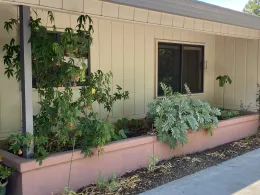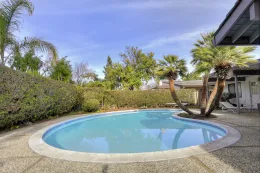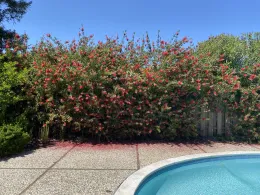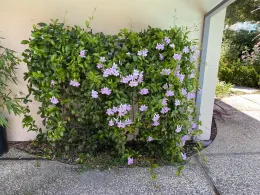Article and photos by Kate Bear -
This article is the second of three articles addressing different aspects of transitioning my yard to one that better meets my desires. The work is ongoing as ideas occur to me. The following is a discussion about rejuvenating a planter, a hedge, and a trumpet vine.

Front Yard Planter
When we moved in the front planter consisted of multi-colored brick and contained a row of Indian hawthorn bushes (Raphiolepis indica) in fair to poor condition. To refresh the planter, we had the brick covered with stucco before replanting it. More soil was needed along with new plants. So all of the shrubs were removed, soil was added, and a new drip irrigation line was installed.
Before re-planting, one of the things to consider was that the amount of sunlight the planter receives varies greatly depending on the time of year and the time of day. The front half of the planter can be in full sun, and the back half is generally totally shaded. The side of the planter closest to the front door gets a lot more sun in the fall, winter, and spring than it receives in the summer.
Initially, we purchased and planted just a few plants, including a Honey bush (Melianthus major), an azalea, a flowering maple (Abutilon hybrid), and two hellebore (Helleborus sp.) plants. Since then, succulents, herbs, and nasturtiums have been added. Plants have been moved within the planter as I monitor their well-being. A hellebore needed to be moved to a shadier area once I noticed that it was receiving too much sun, while another in the shadier part of the planter was quite happy.

In front of the planter is a narrow strip of soil that gets full sun and a lot of heat in the summer. Finding plants that can tolerate these conditions has been a challenge. I put in naked lady lily bulbs (Amaryllis belladona), which will grow in sun and shade. They bloom in late summer and have bright green leaves in the winter and spring. The leaves die back before the plants flower, with pink lily-shaped flowers on bare stems.
Bottle Brush Hedge

There was a bottle brush (Callistemon viminalis) hedge on two sides of the back yard along the fence between it and a pool. It was planted in a very narrow planting space and kept to a height of about five feet. It encroached on the pool at one location, making it difficult to walk past it easily.
The hedge required a major amount of work to remove a lot of dead branches and improve its appearance. First, we had about half of the width of the hedge removed. This provided more space to walk past it by the pool. Then I hired an arborist to address its structure, removing dead branches and making cuts in the right locations. The hedge looked quite naked when completed. It took a year to come back, and after two years, it looks spectacular.
Before pruning, there were no flowers, and we could see over the fence to the adjacent houses. Now the hedge is about twice as tall as before. It blooms beautifully, is alive with bees, and provides backyard privacy.

Trumpet Vine
We also inherited a trumpet vine (Campsis radicans hybrid) that was growing under the eaves at the back patio. It extended into the roof and contained a lot of dead stems. It needed to be removed from the roof to prevent future damage and required rejuvenation. The first step was to remove the vine from between the supporting beams. Then I worked to trace live branches and identify the main stems to keep. There were so many branches that literally grew in large circles from the ground to the top of a seven-foot-tall trellis, that it took some time and patience to sort out the live stems from the dead. I would work for a while, stop, leave it, and come back another day. By the time I removed most of the dead stems, the vine looked spindly. I removed the old trellis and replaced it with two semicircular trellises we owned to create an S-shape.
It took two years for the trumpet vine to fill out and produce flowers. It is shorter than before, but there isn’t a fear of it invading the roof again. Today, the vine is beautiful.
My third article will discuss how color and complexity were increased, and how to attract more pollinators and beneficial insects through the use of low-water and drought-resistant plants.

